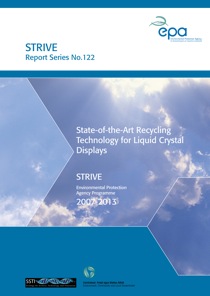STRIVE 122 - State-of-the-Art Recycling Technology for Liquid Crystal Displays
STRIVE 122 - Dr Lisa O'Donoghue
Summary: This project looks at new methods to safely and cheaply recycle LCD screens

The estimated global Liquid Crystal Display (LCD) sales figure for 2013 was 217 million units which illustrates the increased use of LCD panels as the main form of visual display technology. This brings challenges for recycling and disposal of these goods in future years. LCDs contain many hazardous substances: mercury in the backlighting device, organic components such as liquid crystals and plastics contain fire retardants as well as printed circuit boards. Efficient means of recycling these devices while obtaining a high quality of recycled materials is required to avoid the export of this type of waste from Ireland and the European
Union.
Background
Liquid Crystal Display (LCD) technology has evolved and developed over the past two decades to replace Cathode Ray Tube (CRT) display technology as the market leader. This will result in the increasing levels of used LCDs entering into the disposal / recycling stream.
Under the European WEEE Directive and its recast, LCD waste must achieve a rate of recovery of 75% by an average weight per appliance and a direct requirement exists of the removal of the Cold Cathode Fluorescent Lamps
(CCFL) within LCD televisions.
Key points
?
The CCFL tubes provide the backlighting to the screen. Their removal is a prerequisite, as by their design they contain mercury for their successful operation. Mercury is classified as a hazardous material and therefore must be isolated from the LCD waste components during disassembly.
While the recycling methods for CRTs are well established, those of LCDs are as yet in their infancy. This project aimed to address the challenges facing EoL (End-of-Life) treatment of LCD units by analysing LCD build types, structures and component material, to establish traits which may make EoL treatment less of a challenge.
Analysing this data laid the foundation to developing a balanced recoverysystem meeting the needs of economic viability and environmental conservation in future work.
Findings/Recommendations
This project culminated in the design, development, and successful testing of an automated method for the safe removal of the hazardous materials found within LCDs. Its fully automated nature allows a recovery through-put of on average 36 LCDs per hour. This is seen to be approximately ten times higher than manual disassembly methods. However, it is envisaged that through a series of further design reviews, the automated LCD machine, when constructed to an industrial specification, can
exceed a through-put of 80 LCDs per hour.
The obvious economic advantage, along with the intrinsic safety of an automated process, is seen to be a highly desirable technology.
?
Outputs of the project include a prototype, patent and a spinout company.
Associated documentation can be viewed by following this link to our SAFER database.
For Further Information
Contact Dr. Lisa O’Donoghue (Department of Design and Manufacturing Technology,
University of Limerick, Limerick, Ireland – lisa.odonoghue@ul.ie)
Publications connected to this work
O’Donoghue, Ryan and Lewis, 2009, LCD Recycling Technology: An Overview,
International Manufacturing Conference, Trinity College Dublin, 2-4 Sept. 2009.
Ryan, O’Donoghue and Lewis, Investigating the Recyclability of Liquid Crystal
Display TV’s, Flexible Automation and Intelligent Manufacturing (FAIM) Conference,
12-14 July 2010, California State University.